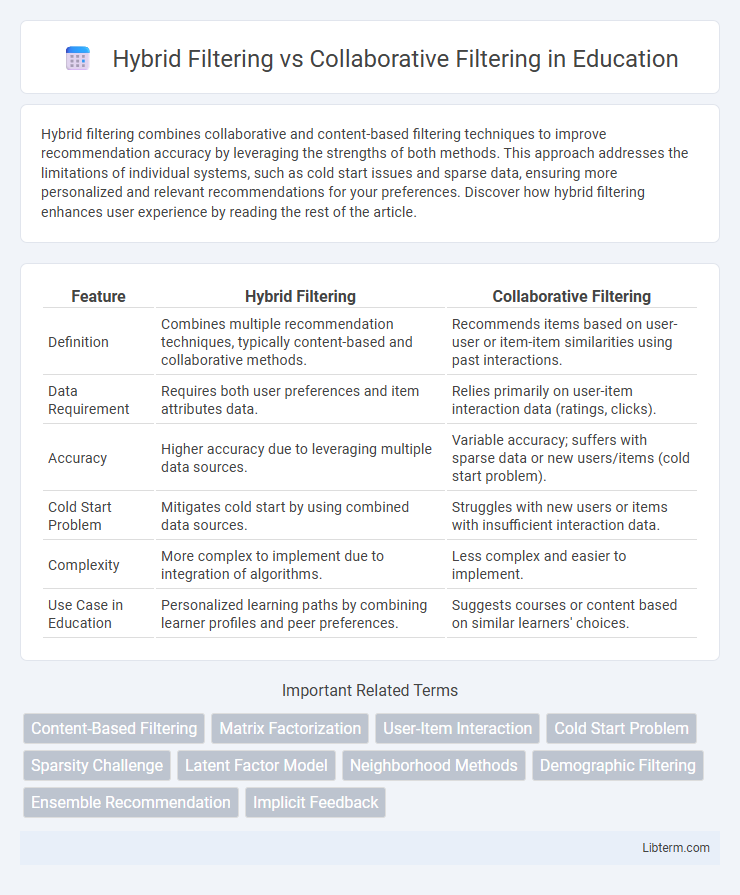Hybrid filtering combines collaborative and content-based filtering techniques to improve recommendation accuracy by leveraging the strengths of both methods. This approach addresses the limitations of individual systems, such as cold start issues and sparse data, ensuring more personalized and relevant recommendations for your preferences. Discover how hybrid filtering enhances user experience by reading the rest of the article.
Table of Comparison
| Feature | Hybrid Filtering | Collaborative Filtering |
|---|---|---|
| Definition | Combines multiple recommendation techniques, typically content-based and collaborative methods. | Recommends items based on user-user or item-item similarities using past interactions. |
| Data Requirement | Requires both user preferences and item attributes data. | Relies primarily on user-item interaction data (ratings, clicks). |
| Accuracy | Higher accuracy due to leveraging multiple data sources. | Variable accuracy; suffers with sparse data or new users/items (cold start problem). |
| Cold Start Problem | Mitigates cold start by using combined data sources. | Struggles with new users or items with insufficient interaction data. |
| Complexity | More complex to implement due to integration of algorithms. | Less complex and easier to implement. |
| Use Case in Education | Personalized learning paths by combining learner profiles and peer preferences. | Suggests courses or content based on similar learners' choices. |
Introduction to Recommender Systems
Hybrid filtering combines collaborative filtering and content-based filtering to enhance the accuracy and diversity of recommender systems. Collaborative filtering relies on user behavior and preferences by analyzing user-item interactions, while hybrid approaches mitigate limitations like cold start and sparsity by leveraging multiple data sources. Incorporating hybrid filtering improves recommendation quality and user satisfaction in various applications including e-commerce, streaming services, and social platforms.
What is Collaborative Filtering?
Collaborative filtering is a recommendation technique that makes predictions about user preferences by analyzing patterns and similarities in user behavior or item interactions. It can be user-based, identifying users with similar tastes to recommend items, or item-based, suggesting items similar to those a user has liked. This method relies heavily on historical data and user-item interactions to generate personalized recommendations without requiring explicit content analysis.
Types of Collaborative Filtering
Collaborative filtering includes two primary types: user-based and item-based filtering, both leveraging past interactions to recommend products or content. User-based collaborative filtering identifies users with similar preferences and suggests items they liked, while item-based filtering focuses on finding items similar to those a user has previously engaged with. Hybrid filtering combines collaborative methods with content-based filtering to improve recommendation accuracy by addressing limitations like cold start and sparsity in collaborative filtering.
Strengths of Collaborative Filtering
Collaborative Filtering excels at leveraging user behavior and preferences to deliver highly personalized recommendations without requiring detailed item information. Its ability to capture complex user-item interactions enables it to identify trends and patterns across large datasets, enhancing recommendation accuracy. The method is especially strong in scenarios with abundant user feedback, quickly adapting to evolving user tastes and promoting content discovery.
Limitations of Collaborative Filtering
Collaborative filtering faces limitations such as the cold-start problem, where new users or items lack sufficient interaction data to generate accurate recommendations. It also struggles with data sparsity, as sparse user-item matrices reduce the quality of similarity calculations. Furthermore, collaborative filtering is vulnerable to popularity bias, often favoring widely rated items and neglecting niche preferences.
What is Hybrid Filtering?
Hybrid filtering combines collaborative filtering and content-based filtering techniques to improve recommendation accuracy and address limitations like cold start and data sparsity. It leverages user-item interactions along with item attributes to generate more personalized and relevant recommendations. Hybrid methods often outperform pure collaborative filtering by blending multiple data sources and algorithms.
Hybrid Filtering Techniques Explained
Hybrid filtering techniques combine the strengths of collaborative filtering and content-based filtering to improve recommendation accuracy by addressing individual limitations such as data sparsity and cold start problems. Methods like weighted hybrid, switching hybrid, and feature combination enable systems to leverage user preferences, item metadata, and interaction data simultaneously, enhancing personalized recommendations. By integrating multiple data sources and algorithms, hybrid filtering delivers more robust and scalable recommendation models suited for diverse applications.
Advantages of Hybrid Filtering
Hybrid filtering combines the strengths of collaborative filtering and content-based methods, resulting in improved recommendation accuracy by leveraging multiple data sources like user behavior, preferences, and item attributes. It addresses common issues of collaborative filtering such as cold start and data sparsity by integrating content information to generate relevant suggestions even for new users or items. This approach enhances user satisfaction and system robustness by providing diversified and personalized recommendations tailored to evolving user needs.
Hybrid Filtering vs Collaborative Filtering: Key Differences
Hybrid filtering combines collaborative filtering and content-based methods to enhance recommendation accuracy by leveraging user behavior and item attributes, reducing common issues like cold start and data sparsity. Collaborative filtering relies solely on user interactions and similarity among users or items, often struggling with new users or items lacking sufficient data. The key difference lies in hybrid filtering's ability to integrate multiple data sources for more robust, diverse, and personalized recommendations compared to the narrower focus of collaborative filtering.
Choosing the Right Filtering Method for Your Application
Selecting the appropriate filtering method depends on the specific requirements and data availability of your application. Collaborative filtering excels in scenarios with abundant user interaction data, providing personalized recommendations based on user behavior patterns. Hybrid filtering combines collaborative and content-based approaches, effectively addressing the cold-start problem and improving recommendation accuracy when user or item data is sparse.
Hybrid Filtering Infographic

 libterm.com
libterm.com